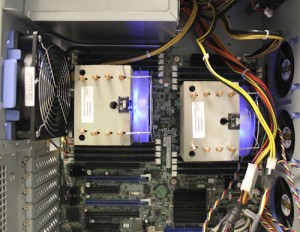TEST SETUP AND METHODOLOGY
 In testing the Samsung XS1715, along with all enterprise drives, we focus on long term stability. In doing so, we stress products not only to their maximum rates, but also with workloads suited to enterprise environments.
In testing the Samsung XS1715, along with all enterprise drives, we focus on long term stability. In doing so, we stress products not only to their maximum rates, but also with workloads suited to enterprise environments.
We use many off-the-shelf tests to determine performance, but we also have specialized tests to explore specific behaviors we encounter. With enterprise drives, you will see that we do not focus on many consumer level use-cases.
Our hope is that we present tangible results that provide relevant information to the buying public.
It should be noted that the XS1715 was tested under Windows Server 2012 R2, as Windows 7 does not currently have native or vendor driver support for this device. All other non-NVMe drives listed in the comparison were tested with Windows 7.
LATENCY
To specifically measure latency, we use a series of 512b, 4K, and 8K measurements. At each block size, latency is measured for 100% read, 65% read/35% write, and 100% write/0% read mixes.
With many PCIe SSDs, queue depth can have a large impact on performance. Unlike SATA SSDs, that normally top out at a queue depth of 32, PCIe SSDs often don’t level out until queue depths of 128 and 256. For our latency testing, we made sure to look at queue depths of 32 and 256, just to get a gauge on how the XS1715 would perform. Overall, the XS1715 performed at the top of the charts for read operations and mixed workloads. The Intel P3700 holds a clear edge for 512B and 4KB writes, but the Samsung drive dominates the other tests.
Overall, maximum latency was incredibly low, specifically for read operations. To put it in perspective, the P3700 has a 100% read, maximum latency of ~15ms at a queue depth of 256, while the XS1715 was at 3ms.
ADVANCED WRITE TESTING
As we talked about in our Micron P400m SSD Review, SSDs have different performance states. Since the Samsung XS1715 is an enterprise SSD, we will focus on steady state performance. With the following tests, we stressed the drive using random 4KB write workloads across the entire span for at least 24 hours. This is more than enough to achieve steady state. The following graph is showing the latency and IOPS across an 11 hour span.
The XS1715 performed exactly as specified over our long term testing. Hitting nearly 115K IOPS is a great result with fairly tight distributions. Now, if you are looking for a drive with pure write performance, you might be better served by the Intel P3700. At the same capacity, the Intel posts 150K write IOPS at a similar consistency.
Even when we only look at the last hour of testing, we can see the tight distribution of IOPS for the XS1715. When compared to the P3700, both drives show similar results. Neither show any troubling outliers, just solid consistent performance. For write operations, the XS1715 does not require large queue depths to achieve good performance.
 The SSD Review The Worlds Dedicated SSD Education and Review Resource |
The SSD Review The Worlds Dedicated SSD Education and Review Resource | 

exorbanant return from advertisements
The correct word is exorbitant.
XS1715 finally here!
Hi guys,
you used pci ex 4x adapter in this review.
Don’t you think this can bottleneck the ssd? I see many high performing pci ssd using x8 interface such as ocz 350 or Gskill phoenix
Thx
The adapters use PCIe 3.0 x 4 to easily make max performance.
3.0 not 2.0, double bandwidth.
My fault.
Thx
Price?
50 BUCKS
How is the Windows boot time with this drive? I was about to get an Intel 750 SSD with SFF-8639 plug but it prolongs the boot time tremendously (relative to how fast SSDs boots these days).
https://techreport.com/review/28050/intel-750-series-solid-state-drive-reviewed/5
https://communities.intel.com/thread/75676
So how do you secure erase the drive? I have one of this but I can’t find any ways to erase it, even linux nvme-cli reports error when trying to use nvme format command. Thx,